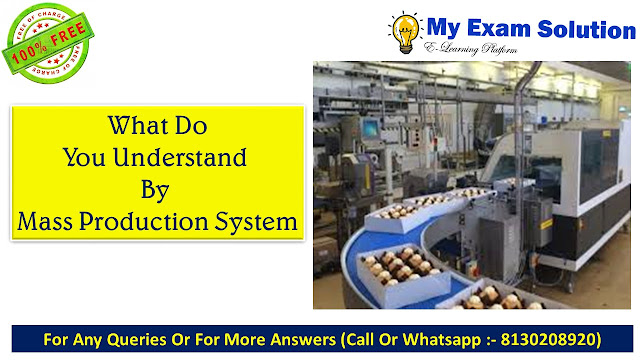What do you understand by mass production system? Explain the features of the mass production system
What Is Mass
Production? Mass production is the manufacturing of large quantities of
standardized products, often using assembly lines or automation technology.
Mass production facilitates the efficient production of a large number of
similar products.
What Is Mass Production?
Mass
production is the manufacturing of large quantities of standardized products,
often using assembly lines or automation technology. Mass production
facilitates the efficient production of a large number of similar
products.
Mass
production is also referred to as flow production, repetitive flow production,
series production, or serial production.
In mass
production, mechanization is used to achieve high volume, detailed organization
of material flow, careful control of quality standards, and division of labor.
An early example of the demand for standardized products in large
quantities came from military organizations and their need for uniforms and
other supplies. Precision machining equipment has led to large-scale demand for
mass-produced products created cheaply with small workforces.
Henry Ford,
founder of Ford Motor Co. (F), developed the assembly line technique of mass
production. In 1913, he pioneered the moving assembly line for production of
the Ford Model T automobile. The reduced manufacturing time for
parts allowed the company to apply the same method to chassis assembly and
drastically reduced the time it took to build the Model T automobile.1
Ford continued
to refine the process, even hiring someone who studied the way people moved
most efficiently. From 1908 to 1927, Ford built more than 15 million Model T
cars.2 As a result of Ford’s mass production, cars became something that
the general public could afford, rather than a luxury item that only a limited
number of people had access to. Since then, Ford’s concept of time- and
space-efficient production has been adopted by most industries, lowering the
costs of everyday items.
Advantages of Mass Production
Mass
production has many advantages. If production is stringently monitored, mass
production can result in a high level of precision because production line
machines have preset parameters. Mass production also results in lower
costs because the automated assembly line production process requires fewer
workers.
In addition,
mass production can create higher levels of efficiency because mass-produced items
can be assembled at a quicker rate through automation. Rapid assembly aids the
prompt distribution and marketing of an organization’s products that, in turn,
can create a competitive advantage and higher profits for a
company. For example, McDonald’s (MCD) has a competitive advantage in
the fast-food industry because of the speed at which it can produce a meal for
time-conscious customers.
Disadvantages of Mass Production
However, not
everything about mass production is beneficial. Establishing an automated
assembly line is capital-intensive
and requires a significant up-front investment of time and resources. If there
is an error in the production design, an extensive investment of time and money
may be necessary to redesign and rebuild mass production processes.
A revision
of the mass production processes may be required for reasons other than errors.
For example, if a pharmaceutical company has a comprehensive assembly line in
place for the production of a popular drug, it would be time-consuming and
expensive for them to respond to a U.S. Food and Drug Administration (FDA) regulatory
change requiring a different production process.
While an
advantage of mass production is that it can reduce labor costs, employees who
remain part of an assembly line may lack motivation because their tasks
are repetitive. The boredom caused by repetitive work can lead to low employee
morale and increased levels of turnover.
Example of
Mass Production
Mass
production now touches most of what American consumers buy, from cars to
clothing to toothbrushes. For example, in 1953, every marshmallow Peep took 27
hours to make by hand. With the introduction of the assembly line, this time
requirement had been reduced to six minutes per Peep, and an average of 4.2
million Peeps were made every day in 2003.3
Ford took
its assembly lines one step further, introducing robots that could unload a
die-casting press in 1961. Now robotics play a major part in much mass
production, with humans standing in as quality assurance.4
Does mass production mean lower wages
for workers?
In some
areas, factory workers are paid less and work in dismal conditions. However,
this does not have to be the case. Workers in the United States tend to make
higher wages and often have unions to advocate for better working
conditions. Elsewhere, mass production jobs may come with poor wages and
working conditions.
Is mass production expensive to set
up?
Creating a
mass production system can be expensive to set up and even more expensive to
alter if changes need to be made after the production has already started. The
cost of setup is generally offset by the efficiency with which products are
made once the system is up and running.
Does mass production produce quality
items?
It can. As
Henry Ford proved, very complex products can be made successfully using
assembly line techniques. However, if there are unforeseen problems with an
element of your product, that issue can be replicated thousands of times before
it may be noticed. This is why product recalls are frequent among
mass-produced items.
ALSO READ:-
- Briefly describe the evolution and need of ‘Management by Objectives’
- Explain the applicability of Consumer Protection (E-Commerce) Rules, 2020
- Explain the determinants of Interpersonal Behaviour
Whatsapp :- 8130208920
Youtube :- Myexamsolution







0 comments:
Note: Only a member of this blog may post a comment.